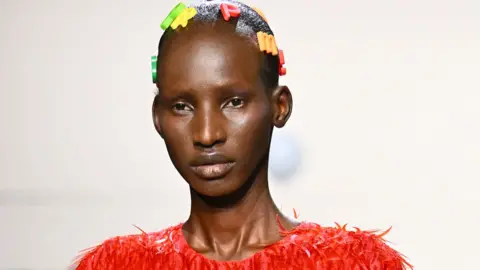The article titled **”They have perfect dark skin”: The African nation home to fashion’s favourite models**, penned by **Wedaeli Chibelushi** for BBC News, delves into the prominent role South Sudanese models have carved out within the global fashion industry. The article highlights the growing visibility of these models on international runways, showcasing the unique blend of cultural heritage and resilience that they bring to the fashion scene. South Sudan, a nation that has faced political strife and challenges, is paradoxically becoming celebrated for its beauty in the modeling sector.
Among the featured models is **Arop Akol**, who exemplifies the shifting landscape of fashion. Akol describes her experience of being a typical off-duty model with a distinctive look, characterized by flowing braids and natural beauty. Her journey from aspiring model at age 11 to walking prestigious runways across London and Paris reflects not only her talent but also the increasing demand for diversity in modeling. Notably, she has even shared the runway with renowned supermodel **Naomi Campbell** at an Off-White show, attesting to the talents emerging from her country.
Akol’s personal experiences underscore the beauty standards that are being redefined by the modeling industry. She mentions how South Sudanese models are recognized for their stunning features, particularly their high cheekbones and rich, dark skin. Indeed, the article observes that from fresh faces like Akol to established supermodels such as **Anok Yai**, **Adut Akech**, and **Alek Wek**, South Sudanese representation is flourishing on global stages. Wek, one of the pioneering South Sudanese models, was scouted in a London car park in 1995 and has since made significant strides, gracing numerous Vogue covers and working with luminary brands like Dior and Louis Vuitton.
The growing prominence of South Sudanese models is not just anecdotal. The industry platform **Models.com** reports that one in five models listed among the top 50 “future stars” possess South Sudanese heritage. This trend is echoed by publications like Vogue, which highlighted four South Sudanese models in their roundup of rising talents expected to take the fashion world by storm in 2025. **Dawson Deng**, the organizer of **South Sudan Fashion Week**, posits that models from South Sudan embody the ideal attributes sought by the fashion industry—radiant skin, height, and a certain aesthetic appeal.
Despite the success, challenges remain for many South Sudanese models. Akur Goi, another South Sudanese model who has worked with high-profile designers, believes the appeal of South Sudanese models extends beyond physical beauty. She suggests their journeys often involve considerable resilience due to the socio-political challenges faced by their homeland. Following South Sudan’s independence in 2011 and the subsequent civil conflict, many fled to neighboring Uganda, sharing a common narrative of overcoming adversity.
The hardships many models encountered upon entering the industry also come to light. For instance, Akol recounts a difficult early experience when an agency scouted her and expected exorbitant fees—contrary to common practice in the modeling world. Additionally, there have been alarming reports of models being taken advantage of, including being told they owe their agencies thousands of euros owing to contractual stipulations regarding travel costs.
Cultural perceptions also complicate the modeling journey for many South Sudanese. Deng notes that some families perceive modeling akin to prostitution, leading to tensions, particularly for young women in the industry. However, some families gradually grow to understand the positive aspects, as models often become significant breadwinners for their households. The article emphasizes the transforming perception of modeling as a legitimate career choice rather than a taboo.
As the fashion industry becomes increasingly receptive to diversity, the outlook for South Sudanese models appears promising. Figures like Akol reflect an optimistic future, citing the ongoing demand for diverse representations and stating confidently, “South Sudanese models are going to go a long way.” With pioneers like Alek Wek continuing to make waves, the emergence of South Sudanese models might inspire even more aspirants, fostering a new generation that embraces both their cultural heritage and their aspirational dreams.
The article concludes by not only highlighting the models and their groundbreaking roles but also encourages readers to look deeper into the stories behind the catwalks and to understand the strength of resilience underpinning these journeys from South Sudan to global fame.



